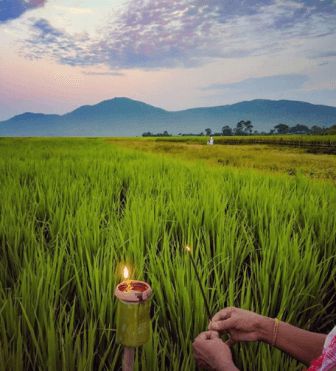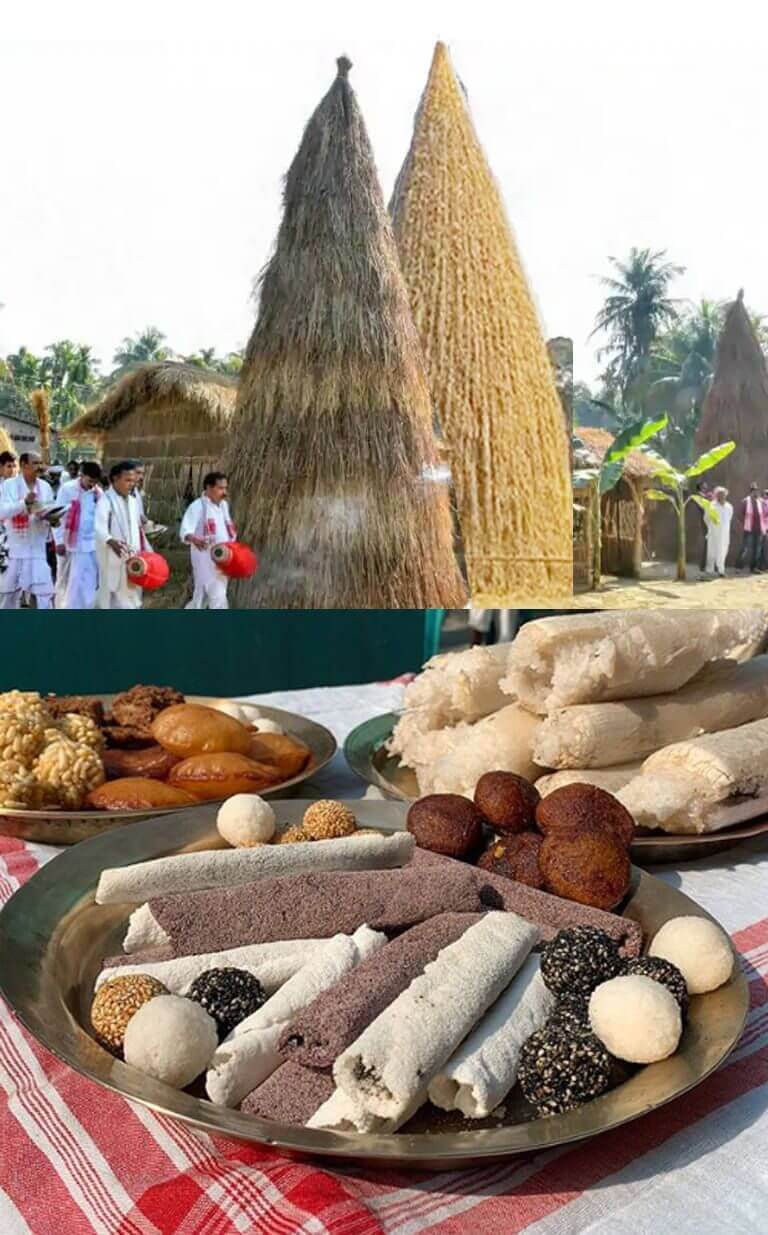About Assam
Bihu
Bihu is a famous and popular festival which is largely based on agriculture. Bihu can be broadly divided into three categories: Bohag Bihu, Kaati Bihu and Maagh Bihu. Bohag Bihu augurs the wish for a good harvest because this is the time when farmers start sowing. Kaati Bihu is observed to mark the cutting and binding of grains and Magh Bihu marks the season of harvesting of grains. In the older times, ‘Bihu’ was not a name given to these cyclic events. Men propitiated the sun, fire, earth and water etc. so that harvest would be good. With the passage of time, the religious aspect dimmed and gave way to gaiety and enjoyment with it. It was from the time of the Ahom kings that Bihu got its prevalent shape and form.
Bohag Bihu


Bohag Bihu is observed from the last day in the last month of Assamese calendar Chata (called Sankranti, transit or passage from one zodiacal sign to another). Earlier Bohag Bihu was celebrated for seven days together and each day had a different name like Goru Bihu (for cows), Manuh Bihu (for mankind), Tator Bihu (for loom), Gossain Bihu. (for Gods), Nangalor Bihu (for plough), Bihu for domestic animals and Chera Bihu (concluding day of the Bihu). Bohag Bihu is the season of unfettered greenery with early monsoon, and with Nature clad in beautiful colours. Such variety is not to be found elsewhere. On the first day of this Bihu, which is meant for the cows, in the early hours of the morning cows are taken out for washing in .the nearest ponds and ‘Beels’. With the help of a small three pronged shaped Bamboo implement, brinjals and water gourd are cut into pieces and hurled at the cows. Other vegetables like bitter gourd, turmeric and Thekera (the gamboze fruit) are also used. These implements are interchanged with others to ward off the evil. Later in the evening when the cows return ho-me they are tied to new Pogha (rope for tying cow) and the shed is filled with smoke to prevent any evil. Cows are indispensable for cultivation and thus such treatment on the special day.
Another important ritual of this day is that ladies and girls apply henna and mehendi on their hands and feet. Mehendi (locally known as Jetuka) is a way of bringing colour to life, apart from its medicinal properties. Manuh Bihu follows Goru Bihu when people visit relatives and exchange Garnochas (a kind of towel woven in cotton). Bihuwan or this Gamocha is a symbol of dignity in Assamese society. Jalpaan, a special food item, is an important part of Bihu.
Kaati Bihu:
Kati Bihu Towards the end of Aahin (sixth month of the Assamese calendar) month the farmers’ labour brings fdrth the golden glow on the ripe grain. In the month of Kaati (seventh month of the Assamese Calendar) following Aahin, the farmer gets ready to welcome Lakshmi, the goddess of wealth and prosperity. It is done by lighting chakis (earthen lamps) under the Tulsi (black basil) plant. Kaati Bihu is the time when the granary is empty hence lending the name Kangali Bihu. The granary is also adorned with an earthen lamp so as to auger a full granary throughout the coming months. There is another custom of lighting an earthen lamp on a long sliver of a bamboo. There is a belief that this is done to ease the departed one’s soul to the other world. This ‘earthen lamp’ is also called Askash Banti. Parallel to this Bihu, the festival of Deepavali is also celebrated, with the lighted ‘diyas’ dispelling the darkness.

Magha Bihu

It is observed to celebrate the harvesting of grain. It is usually held on the 14th and 15th of January (1st and 2nd Maagh, the tenth month of Assamese calendar). The first day is called Uruka, when people build a temporary shed and have feast. Four bamboo rods are placed beside the four posts and then a meji (a pile or column on split fire-wood or straw erected for burning in the early morning of the Maagh Bihu) is built in the shape of a temple, in a conical shape. In the early hours of the next day people take a bath and after the meji is lighted, they pay their respect and the Bihu is officially started. The ashes of the burnt meji is scattered over the fields, for it is believed that doing so would increase the fertility of the soil. Delicacies like pithas are served together with Jalpaan. Various kinds of potatoes (Kaath Aloo, Mitha Aloo etc.) are also eaten on this day. Many games are also played keeping the spirit of the Bihu alive. Bihu is the treasure of the Assamese, something which they have to protect at all cost. But now commercialisation has cost Bihu some of its lustre. In place of Chira, pithas, curd, cakes, biscuits etc. have taken over. Bihu dances and songs have been restricted to the stage with its being brought within the bounds of competition.




